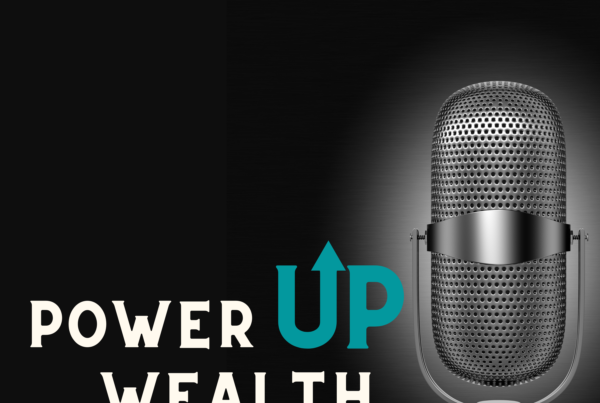Power Up Wealth podcast – Episode 65 – Watching Inflation
Sharla Jessop 0:00
When looking at the US economy and inflation, you may wonder if we’re moving at a regular pace or moving at a faster clip. Today, James Derrick will talk about inflation and how it could be compared to people movers at the airport.
Welcome to the SFS Power Up Wealth podcast where we provide impactful insight and expert opinions on timeless financial principles and timely investment topics, preparing you to make smarter decisions with your money.
James, thanks for joining me today.
James Derrick 0:48
So glad to be here.
Sharla Jessop 0:50
James is Chief Investment Strategist at Smedley Financial and he holds a Chartered Financial Analysts designation and an MBA. James, like many others, you and I have spent a lot of time at the airport hopping on and off the moving walkways trying to save some time, maybe a little energy. Explain how you contrast interest rates to these moving walkways.
James Derrick 1:08
Well, you may remember when they first opened up the new terminals at the Salt Lake International Airport, they didn’t have moving walkways, yet, it took a long time to get to some of those gates like a really, really long time. In fact, it’s about two thirds of a mile. So you had to plan accordingly. And eventually they put in the moving walkways, and it makes a world of difference. I mean, like you’re moving at such a fast speed. And in fact, a lot of people didn’t know this. I didn’t know this till I started doing some research. But those moving walkways move at 1.4 miles per hour. So if you’re walking at, let’s say two and a half miles per hour, now you’re moving at approximately four miles an hour, which is pretty good pace.
Sharla Jessop 1:46
When I’m headed in the airport. I like that it’s moving quite quick.
James Derrick 1:49
Yeah, in fact, I went home and I told my kids and I was like you won’t believe this they move at 1.4 miles an hour. And they said, well, why do they move so slow? Why don’t they move at, why aren’t they moving it like three or five miles an hour? And I was like, well, have you ever, like lost your balance when you step on or off of one of those things? Like just imagine if ever.
Sharla Jessop 2:00
Requires a hard hat to use a moving walkway.
James Derrick 2:11
So and the same thing is kind of true with us and the economy and inflation and interest rates. The change in speed can be pretty abrupt, and it can cause us to stumble. And certainly in the stock market and the bond markets, we see that kind of thing happen a lot as people adjust to either the quicker speed of the moving walkway, or stepping off the walkway.
Sharla Jessop 2:35
Which can be abrupt.
James Derrick 2:36
Which feels abrupt. Which is kind of what happened about 20 months ago, when the Federal Reserve began raising interest rates.
Sharla Jessop 2:43
As they started raising interest rates, we saw a lot of changes in inflation and the impact to a lot of people. Talk about that. Talk about what happened with inflation and interest rates going up.
James Derrick 2:53
Well, the Federal Reserve always had the opinion that inflation was transitory or temporary, and that it was mainly the cause of disruptions in supply during the COVID pandemic. And I think that in hindsight, we can say this was only partially true, although I think that many politicians and Federal Reserve members will still tell you that was the cause. I think it’s also a fact that we’ve seen prices, some prices stay high. So some have gone up and come back down, and some have stayed high. And I think that that is where we can distinguish between what was transitory and what was not. What was temporary, what was not. So for example, I remember that we had some friends building a house back in 2021. And they watched the price of lumber every single day. And not only the price, but I mean, they couldn’t get what they needed to build their home. And so the fact that it had gone up like 400% had a major impact on them. I mean, the timing was really tough for them. And what we’ve seen now is the price of lumber has come back down, but the price of homes has not. And so this divergence in prices is happening all over the economy, we see it in lots and lots of things. Another good example would be the price of oil and gasoline two years ago, was significantly higher than it is today. It went way up. It came all the way back down to normal levels, but the price of cars hasn’t. The price of auto insurance is up over 20% in the last 12 months. And I doubt it’ll come back down either. So one way to look at it is is that the prices for input and commodities like lumber and gasoline have gone up and returned back to their old levels, but finished products like homes and vehicles services like insurance they’ve gone up and they have not come back down. I don’t think they will.
Sharla Jessop 4:43
We probably won’t see relief in some of those areas.
James Derrick 4:45
No, I mean, I think that there’s potential for some relief. For example, it’s not uncommon to see home prices fluctuate with the economy, but as far as all finished goods, it doesn’t look like they’ll ever come back to where they were. And that’s pretty normal. I mean, inflation went up over 9%. If it comes back to the Feds target of around 2%, that’s still positive inflation. So and ideally that would be what would happen, it actually would be pretty devastating to the economy If we saw negative 9% inflation. That would be dangerous. That would be like Great Depression type phenomenon. And so we actually, even though it sounds nice, we don’t want to see that. But what we want to see is just a return to a very steady 2%, where we don’t have to think about prices every day.
Sharla Jessop 5:30
And a lot of us have hit by inflation in our pocketbooks. So even though we see inflation coming down, hear numbers that it’s coming down. Some of us as consumers don’t really feel like things have come down.
James Derrick 5:42
Absolutely feels terrible. And you see this in public polls, and a lot of the politicians are like, well, what’s going on? Like, the economy’s fine, people have jobs, why do they feel so terrible about things, but there are several examples I could give. I mean, just recently, Coca Cola came out with their earnings and they said, well, and forgive me, I’m just gonna round the numbers according to my memory, but they they said, look, sales of units, or mostly soda, were down 6%. People are buying 6%, less soda. That’s the bad news for Coke. The good news is, is they raise prices by 9%. And so they came out ahead anyway.
Sharla Jessop 6:16
So they’re looking great. Consumers are drinking, we have less soda, and we paid the same price.
James Derrick 6:21
We know we paid 9% more and we got 6% less. I mean, like it couldn’t be worse for consumers. And that’s just soda, even if you don’t drink soda, like are you eating out because restaurants have gotten very expensive. Eating at home has kind of gone the way of lumber and gasoline where it went way up, and it’s come back down quite a bit while eating out has gone up and not come back down. When you start multiplying it through everything that we spend in in our budget, it begins to have a major impact. And people feel it and even if you’re not calculating it, you’re feeling it. Because you’re, you’re buying the same things you used to buy or similar, and you’re finding that your money doesn’t go as far as it used to. And so this is playing out for everyone.
Sharla Jessop 7:05
And it’s hard. Low interest rates have have been good in the past for the economy. But talk a little bit about interest rates and lenders and what we’ve what’s happened in the past versus what we’re seeing now.
James Derrick 7:15
So the inflation has a big impact on rates, if you have higher inflation, you’re gonna have higher interest rates, otherwise, it creates just a weird phenomenon. I mean, imagine if you knew that, uh, your home was going to increase in value by 5% a year, a pretty reasonable expectation I think on average, but you could get a loan at 2%. You’d go out and buy as much real estate as you possibly could, because it would feel like free money. And so low interest rates have this impact, where if they’re too low, they cause more inflation. And so therefore, interest rates rise, as inflation goes up. Hopefully I explained that well enough. I actually had a friend who bought a house in 2021. And that’s exactly how he felt. He’s like, this is like free money. So interest rates typically will rise with inflation. And when rates are low, the plus is that it’s easy money for borrowing to buy a home, for a business idea. And so a lot of ideas, let’s say, are able to get easy money. The negative is for the savers. The savers get very little in return. And then they begin taking more risk. In fact, Adam Smith wrote about this in the Wealth of Nations. And this book, this is he is the father of economics. He wrote The Wealth of Nations way back in 1776. And in this excerpt, he’s actually quoting someone from before his time, who said the worst loans are made at the best of times. And I’m sure that wouldn’t surprise any bankers out there listening to this. I think that’s that is what happens, because you’re looking for when rates are low, you’re looking for some type of positive return. But then as rates rise, if you’ve locked in those low rates, that can be quite difficult. And, and we’re seeing that play out with banks right now. Higher rates are a little different, because the benefit, obviously, is the opposite. The savers are making more money, but you have higher borrowing costs. If you don’t pay off your debt, you will eventually be forced to refinance your debt at the higher interest rates. And this is kind of what it’s like stepping off the moving walkway. And you’re just like, wait, what, like I had a 3% rate, and now I have an 8% rate. And if you’re a business in a situation like that, it will be quite painful. And so there’s, there’s a great divergence between the profitable and the unprofitable companies right now. Because some of them are receiving better rates and others are paying worse rates if that makes sense. So the higher rate really causes a divergence between those companies.
Right, think about it. If you have more if you’re paying a higher rate, more of your profits are going to pay expenses and pretty soon you’re not going to be profitable anymore.
Exactly. And if you’re a large company making a profit, I mean, you’re probably excited that they’re somewhere decent to put those savings while you wait to put them to use.
Sharla Jessop 10:00
Like some of the larger companies who we know have excess of cash.
James Derrick 10:04
Right.
Sharla Jessop 10:04
At this point, they’re happy to have it because they’re making good money.
James Derrick 10:33
Absolutely.
Sharla Jessop 10:34
Talk a little bit about what’s going on more recently, because we’ve there’s been a lot of talk about interest rates staying higher, longer, and we just had inflation, we’re recording this inflation numbers just came out the other day, a little bit higher than anticipated.
James Derrick 10:22
You know I like the phrase higher for longer. I think that it’s kind of catchy and describes the situation. Typically, you know, unless there’s a recession, it’s hard to get inflation way down. And so that’s what we’re seeing and expectations that rates will be coming down have really eased financial conditions. And we don’t want to get too technical in this podcast. But basically, like, money has gotten easier in the last several months. That has kept the economy going. And as long as the economy is going strong inflation may not make it down to the Feds goal of 2%. That just means basically what the Fed is, I guess there are a couple of catchy phrases we could use to describe how the Fed feels about all this. One is, if it ain’t broke, don’t fix it. And I think that is basically how the Fed is feeling right now, like, hey, like it’s working, we are in no hurry to lower these interest rates, they’re just going to wait, and there’s some risk to that, we, you know, just means that we’re going to survive a little bit longer without the lower interest rates. Without being on the moving walkway. We’re gonna have to walk a little bit longer. It’s pretty normal. We’ve been here before, you know, the 1990s, the 1980s, the 1970s. I mean, we’ve we’ve had higher rates for some time, it’s just the been the last 15 years, when we’ve been near zero. We’ve kind of distorted things, and we’ve gotten used to it. But it actually wouldn’t be that bad to have interest rates stay at a reasonable level, where we can all get some decent returns on our savings.
Sharla Jessop 11:47
I like that. I think that’s good to think about long-term.
James Derrick 11:51
Yeah, it’s a pretty exciting scenario, especially if we can get inflation to calm down a bit without sending us into a recession.
Sharla Jessop 11:59
That’s good information. James, thank you.
James Derrick 12:02
Thank you.
Shane Thomas 12:08
Thank you for joining the Power Up Wealth podcast. Smedley Financial is located at 102 S 200 E Ste 100 in Salt Lake City, UT 84111. Call us today at 800-748-4788. You can also find us on the web at Smedleyfinancial.com, Facebook, Instagram, Twitter, and LinkedIn. The views expressed are Smedley Financials and should not be construed directly or indirectly as an offer to buy or sell any securities or services mentioned herein. Investing is subject to risks, including loss of principal invested. Past performance is not a guarantee of future results. No strategy can assure a profit nor protect against loss. Please note that individual situations can vary. Therefore, the information should only be relied upon when coordinated with individual professional advice. Securities offered through Securities America. Inc., Member FlNRA/SIPC. Roger M. Smedley, Sharla J. Jessop, James R. Derrick, Shane P. Thomas, Mikal B. Aune, Jordan R. Hadfield, Registered Representatives. Investment Advisor Representatives of Smedley Financial Services, Inc.®. Advisory services offered through Smedley Financial Services, Inc.® Smedley Financial Services, Inc.®, and Securities America, Inc. are separate entities.




